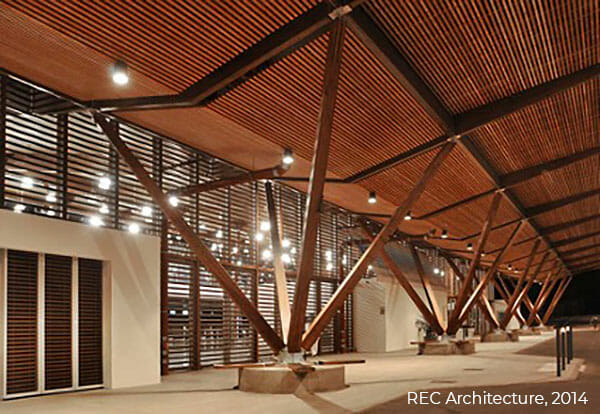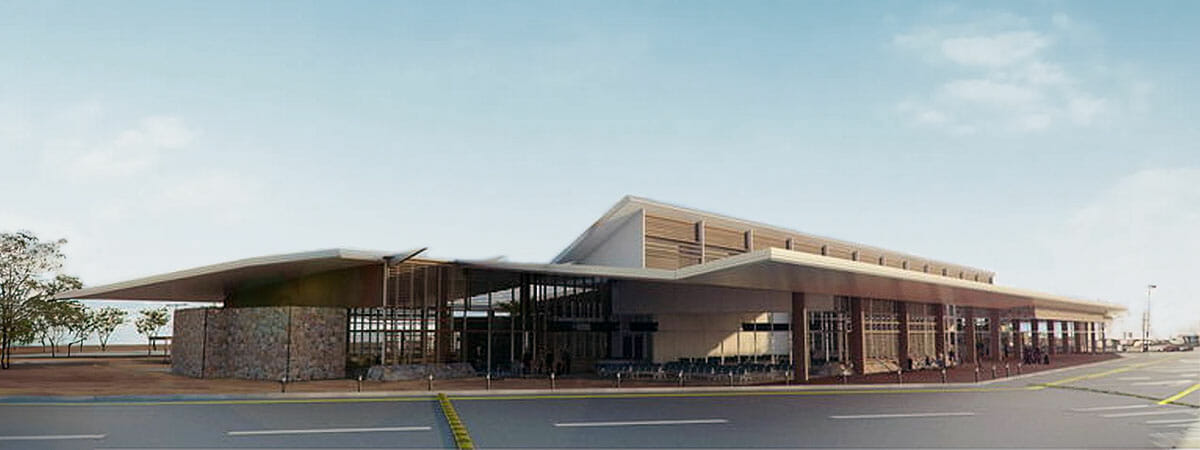The 20th century was a paradigm shift in architecture (the good one) that can be defined as the passage from the tectonic to the mechanical / from the mechanical to the electronic / and from the electronic to the thermodynamic.
What is thermodynamic beauty? It consists in trying to do the most with the least, using constructive solutions appropriate to a given place. It is beauty that results from putting the true concept of sustainability into practice.
There are airports where sustainability is practically (as in decades ago) an actual matter of survival, not an imposed marketing concept.
The beauty of sustainability should prevail no matter what functional program we are solving. Be it an airport or a house. However, in general, the design of current airport terminals takes into consideration a series of characteristics that help little to achieve such beauty.
 Contemporary terminals usually have bays with large spans, emulating those first hangars that served as shelter for biplanes at the beginning of the aviation era and that have led to the huge check-in halls that we know today. Evidently, these bays demand unconventional structural solutions, often with elements that require a lot of energy in their manufacturing, transportation and installation.
Contemporary terminals usually have bays with large spans, emulating those first hangars that served as shelter for biplanes at the beginning of the aviation era and that have led to the huge check-in halls that we know today. Evidently, these bays demand unconventional structural solutions, often with elements that require a lot of energy in their manufacturing, transportation and installation.
Likewise, these large vestibules, as well as the boarding halls and many other areas of the terminals, frequently have excessive heights. The justification is usually the scale of the space and the large number of people who are in it simultaneously. However, these immense volumes demand an unjustifiable amount of energy to try to heat/cool, illuminate and/or maintain them.
These spaces can be equally pleasant with much less height, as occurs, for example, at the airport in the Murcia Region, which has a boarding hall that is only 360 cm high.
 Another of the great attractions of passenger terminals is the direct view of the airfield. Indeed, the scenery of the apron and the landing and take-off runway are almost mesmerizing. But this circumstance does not justify the design of complex and immense curtain walls, regardless of whether the orientation of said view is, for example, towards the harsh west found in our latitude. There are means of opening up these façades while effectively protecting them from solar radiation, as in the case of Dzaoudzi Pamandzi international airport, located in the French department of Mayotte and whose airfield-facing façade is, literally, a fully covered Venetian blind.
Another of the great attractions of passenger terminals is the direct view of the airfield. Indeed, the scenery of the apron and the landing and take-off runway are almost mesmerizing. But this circumstance does not justify the design of complex and immense curtain walls, regardless of whether the orientation of said view is, for example, towards the harsh west found in our latitude. There are means of opening up these façades while effectively protecting them from solar radiation, as in the case of Dzaoudzi Pamandzi international airport, located in the French department of Mayotte and whose airfield-facing façade is, literally, a fully covered Venetian blind.
Designing an airport in a warm and relatively humid climate, as is the case of Malaga, can in no way be the same as doing it in more northern latitudes. Probably the tools that we should use in a Mediterranean airport have more to do with concepts such as shaded areas, shade, patios (which can also be used for future expansions), natural ventilation or the use of thick enclosures with the ability to “retain” heat (thermal inertia). Seeking the compactness of architecture with walls that can be inhabited and with solutions that seek freshness and cast shade on the building itself and its surroundings.
Baltra Airport. Galapagos Islands, Ecuador.
Nowhere are these strategies as important as in an airport located on an island. In a previous post we already shared how the AERTEC team, together with Cali based architecture studio Espacio Colectivo, solved the design of the passenger terminal on the island of Providencia in the Colombian Caribbean, precisely putting these principles into practice. One of the references we had looked at at that time was what is possibly one of the best examples of a comprehensive solution that not only considers thermodynamic design, but also aspects such as transportation, execution and subsequent maintenance: the airport of the Galapagos Islands, located 2400 km from the coast of Ecuador, the country to which it belongs.
This magnificent project fully leverages the extreme climatic conditions of its location, since its remote location does not allow for operation and, above all, maintenance like any conventional airport.
In this case, sustainability is practically (as it was decades ago) a matter of survival, not an imposed marketing concept. And it is striking that the solutions applied are overwhelmingly simple, an example of how to resolve these complex situations that only depend on paying close attention to the conditions of the setting, having reliable climatic data and managing it precisely and appropriately to optimize the use of energy, lighting and water consumption.
The main strategies carried out in the Galapagos are:
- The use of recycled material from the demolition of the old terminal as well as other types of uses.
- Reducing energy and water consumption, through the production of clean energy and the treatment and reuse of gray water.
- And the use of natural lighting and ventilation.
Implementation of these “major guidelines” begins from the moment the first project decisions are made and extends to the operation and maintenance of the infrastructure. Let’s see how.
The first decision that essentially impacts the behavior of the terminal is its location. In this case, the building is placed strategically with respect to its setting, slightly modifying its orientation until it is set in the direction of the prevailing winds to make the most of the local breeze. This consideration regarding weather is unusual when planning an airport. In a Master Plan, when the first decisions are made regarding the position of the passenger terminal with respect to the transit area and the airport complex, this aspect is rarely taken into account. In fact, the wind at an airport is only an aeronautical input. It is the one that determines the orientation of the runway for obvious operational reasons.
The very shape of the building itself promotes the freshness generated by the movement of air through the installation of covered and open patios, as well as through large skylights that favor not only air circulation, but also the entry of natural light.
Equally essential is the materiality and construction systems chosen for the construction of the terminal. All materials used on site are recycled or have low environmental impact. Aggregates from local quarries were used for the agglomerates, stones from the island of volcanic origin were used for the coatings, and even the structural steel and wood came from both the old terminal and dismantled oil extraction fields in Ecuador.
In addition, both the cover and the vertical walls are plastered in light colors that reflect solar radiation and help maintain indoor temperature.
Or, for example, concrete is used instead of asphalt on the landing strip itself, which means a reduction in the surrounding temperature of between 2 and 5 degrees Celsius (heat island concept).
As regards construction, prefabrication was chosen as a strategy to avoid greater pollution in Baltra. To do this, the elements of the different systems were assembled on the continent and later assembled on the island.
The scarcity of fresh water is another problem that must be solved in such a remote location. The shape of the building also tries to respond to this need. For this reason, the roof of the building is designed in a way that favors the collection of rainwater. The airport also has its own desalination plant, as well as a wastewater treatment plant that allows recycling of a good percentage of the water used in daily operations.
Power generation is another great challenge. In this case, all the airport’s electricity comes from renewable energy, solar or wind. A photovoltaic installation was built whose solar panels are installed as a cover for a good portion of the roads of the complex. A third of the electricity demand comes from this installation and the rest from the wind turbines strategically located at the aerodrome.
It should be noted that this intervention philosophy extends from the design of the building to other areas. For example, in terms of equipment, baggage claim racetracks operate using a gravity system based on inclined planes where suitcases are supported on rotating rods and cylinders without the need for an electrical supply, or also in the case of urinals, where water is not used, thus favoring a reduction in consumption.
Less energy, less consumption, less dependence on mechanical systems, fewer maintenance problems.
The image of Baltra airport bears little resemblance to that of a conventional contemporary airport. And perhaps that is the problem: that when one thinks of a house in Norway, one does not imagine an open construction surrounded by solar protection elements. But when we think of an airport terminal, regardless of its location, we always imagine the same building.



